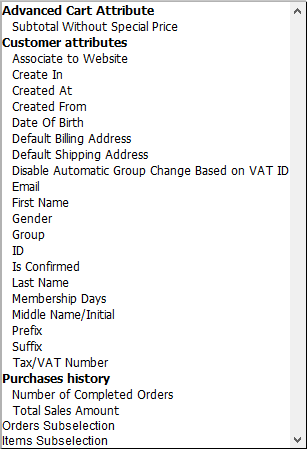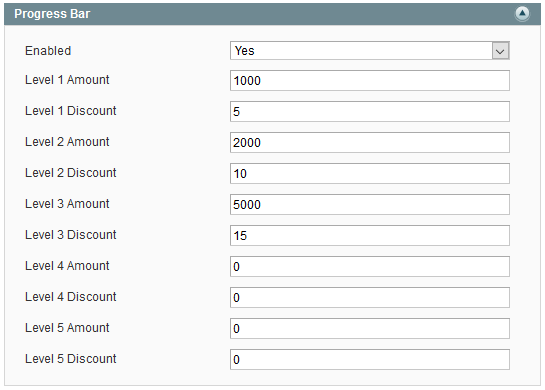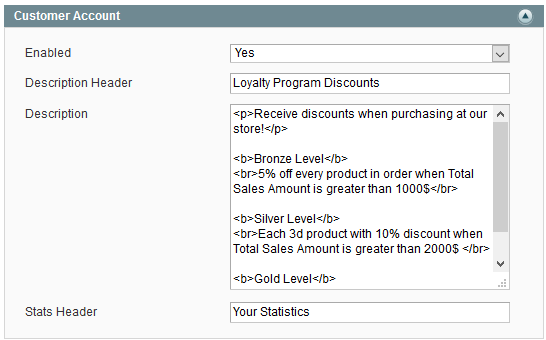Sidebar
magento_1:special-promotions
Table of Contents
See the way the Special Promotions extension works.
Guide for Special Promotions
Common promotion settings
Settings listed here are common for most of the promo actions. They will work the same for any action you choose to use
- ‘Discount Amount’ field indicates discount percent applied by a rule. For example, if you type in 100 here the item will get 100% discount.
- ‘Max Amount of Discount’ field sets the limit to the amount of discount the rule will apply to a cart. For example, if you try to apply 100% discount on a product that costs $400, but this setting is set to 200, then the rule will only deduct $200 from the cart totals. Leave it blank for no limitations.
- ‘Maximum Qty Discount is Applied To’ field indicates the maximum number of items for which the discount should apply. Leave it blank for no limitations.
- ‘Free Shipping’ is a default Magento setting which, when enabled, will replace shipping charge for the order (or specific products, depending on which option you've selected) with zero.
- ‘Stop Further Rules Processing’ is another default Magento setting which is designed to stop the lower priority rules from being applied.
- ‘Calculate Discount Based On’ the setting controls the base price which will be used to calculate the discount amount.
- ‘Skip Items with Special Price’ please see Extension settings section.
Conditions and Actions
For the most promo actions, you can use product attributes in both Conditions and Actions tabs. But what is the difference? Think of “Conditions” and “Actions” as of “Cause” and “Effect”. It means that Conditions you set define in which situation the rule will be applied, no matter the discount calculation settings. And product attributes you set in the Actions tab will determine to which products the discount will apply when Conditions are met.
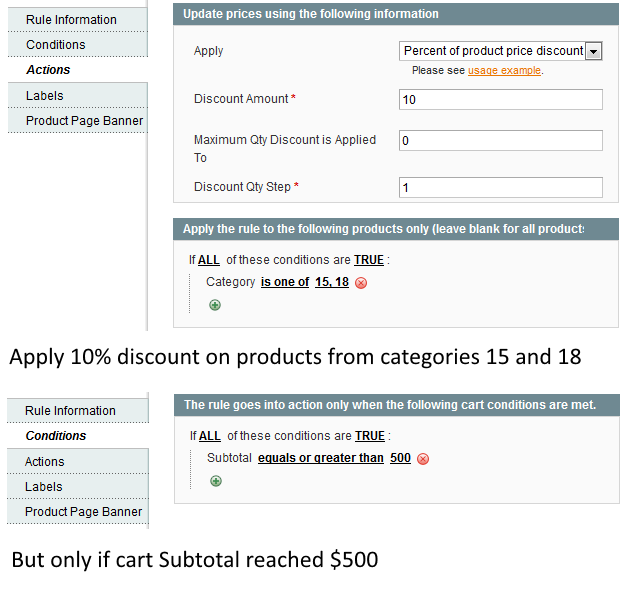
Conditions and Actions are extremely useful for advanced promotion setups, but it is very simple to make a mistake while configuring them. Please check our collection of the most popular mistakes Magento store owners make with the tips on how to do it right.
Usage examples
At first, we’d like to warn you about the specific Magento behavior when applying a catalog price rule and a cart price rule simultaneously.
Let’s check it on the example.
1) You set up the catalog price rule which gives a 20% discount to Pearl Stud Earrings. That’s what your customers will see on the frontend:
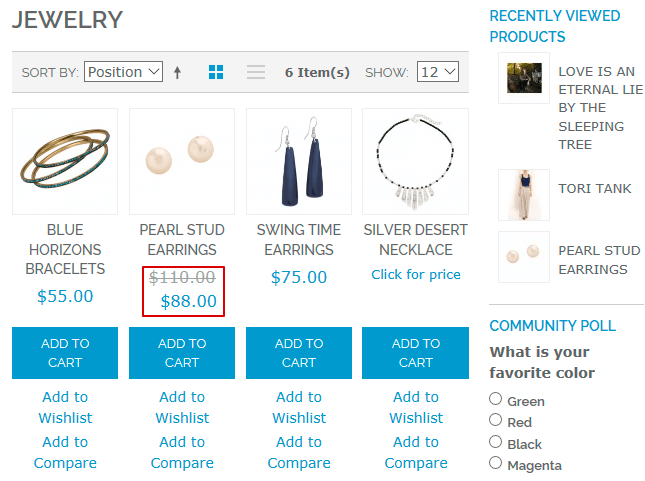
2) Then you decide to activate the rule which gives a 40% discount to the same Pearl Stud Earrings when a customer buys two products from your site. You want the discount to be calculated based on the original prices, and here are your settings (don’t forget to set up the SKU of the promo earrings on the Define Y Product tab):
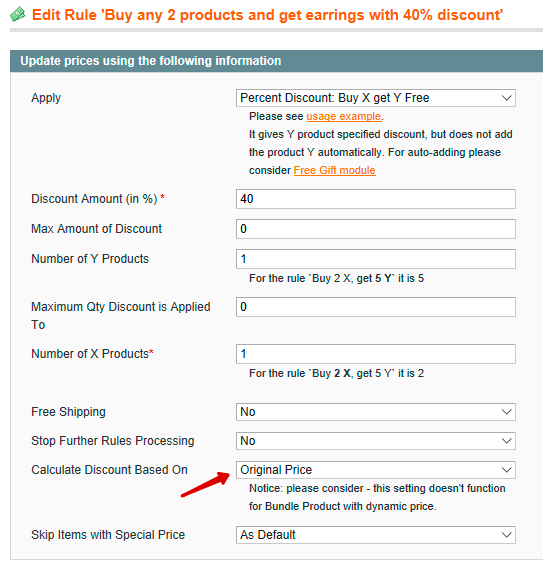
3) When both rules are activated, the discount in your customer’s shopping cart, matching these rules conditions, will be calculated as follows:
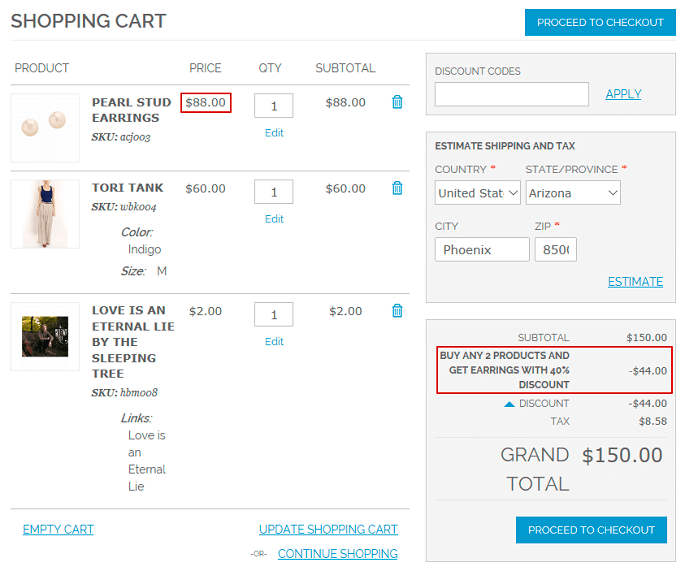
You can notice, that the Pearl Stud Earrings’ price is $88 (that is its original price with 20% discount according to the catalog price rule). And the 40% discount applied equals to $44, which is not 40% of the displayed price. That is because this discount is calculated from the original price of the earrings – $110. Sometimes this can lead to misunderstanding. But it’s the right result. Please, take it into consideration when applying the rules.
Below you can find usage examples for the promo actions included in the Special Promotions extension.
Please note that the steps for configuration of common fields were skipped. You can find general information on these fields in Common settings section.
Popular
"The Cheapest" action
This rule may be advertised as - ‘Buy 3 and get the cheapest product for half the price’, - ‘Buy 6 get 2 cheapest products for half the price’. Please note that customers will get a discount for the items from the same categories only and they will never get a discount for more than 2 items as the rule has ‘Maximum qty the discount applied to’ set to 2.
- Step 1. Choose ‘The Cheapest, also for Buy 1 get 1 free’ action for the ‘Apply’ field.
- Step 2. Use the ‘Discount Qty Step’ field to specify how many products customers need to buy for the rule to take effect. If you indicate 3 like here, that means that from every 3 items purchased customers will get 50% off for the cheapest one. If you leave ‘0’ (zero), customers will get only 1 free item per order (if conditions are met).
- Step 3. You can use all standard Magento conditions with new actions. If you would like to provide products for free or discount items only from a certain category or of a particular brand, etc, please indicate the category, brand and other conditions here.
As you can see from the screenshot below, we have applied conditions to the categories 16 and 17.
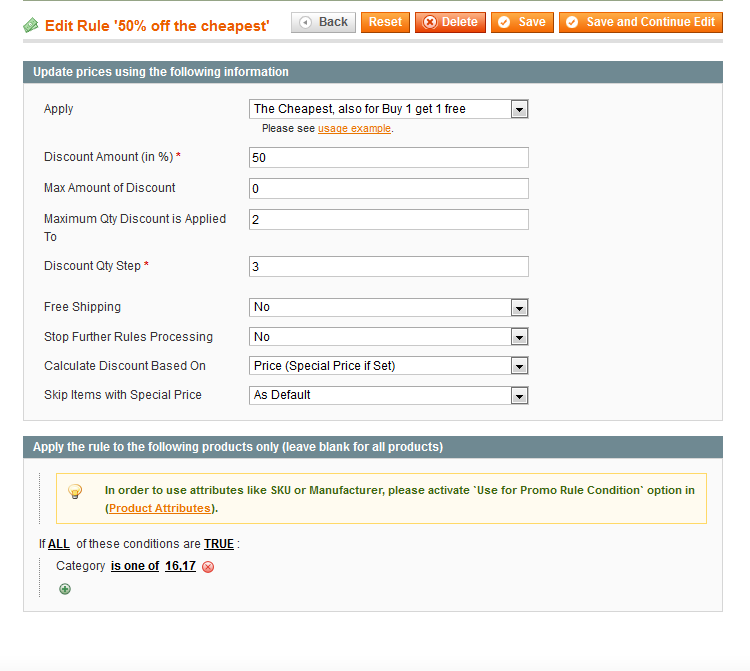
And this is how the result for the rule above will look like
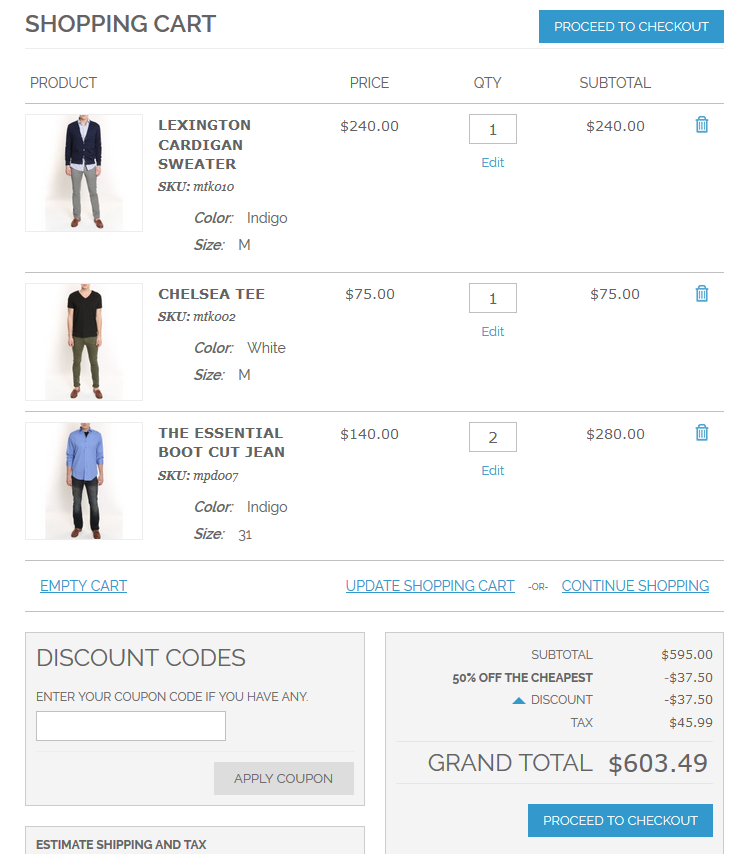
"The Most Expensive" action
It works exactly the same as The Cheapest action, but instead of applying the discount for the cheapest product in the cart it will discount the most expensive.
"Get a discount for each amount spent" action
With this action you can set promotions like ‘Get $5 off each $250 in the cart’
- Step 1. Choose the ‘Get discount for each amount spent’ action for the ‘Apply’ field.
- Step 2. Set ‘Amount to Spend’ to determine the cart amount for which discount will be applied.
- Step 3. Use the ‘Discount Amount’ field to specify the amount which will be taken off the cart total each time the amount in ‘Amount to Spend’ is reached.
The rule below will get $5 off each $250, it means that when the subtotal reaches $500 the discount will be equal to $10, for $750 in the cart the discount will be $15 and so on.
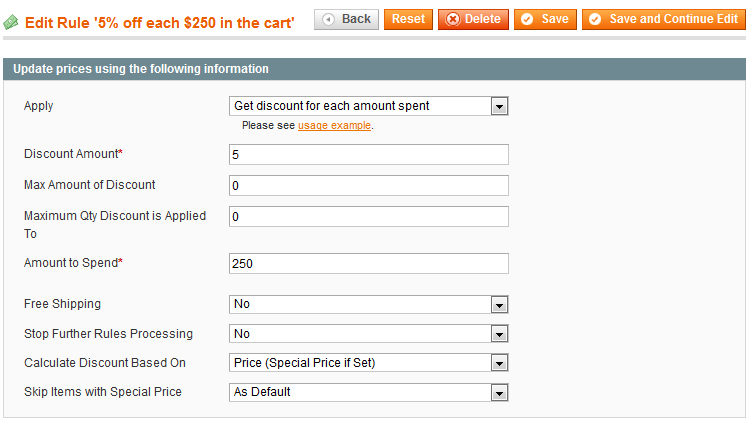 And this is how the result might look like
And this is how the result might look like

Buy X Get Y (X and Y are different products)
"Percent Discount: Buy X get Y Free" action
Due to this action, you can create promotions like ‘Buy 3 phones and get a camera with a 20% discount’.
- Step 1. Choose the ‘Percent Discount: Buy X get Y Free’ on the ‘Apply’ field.
- Step 2. Use the ‘Number of Y Products’ setting to indicate the number of ‘Y’ items to which the discount will be applied.
- Step 3. Use the ‘Number of X Products’ setting to indicate the number of ‘X’ items. If you specify 1 like here, it means that a customer will have to buy 1 ‘X’ items to get a 20% discount for one ‘Y’ item.
- Step 4. Use the conditions section of the ‘Actions’ tab to specify ‘X’ items, by which the discount is triggered. In this case, we indicated that ‘X’ items should be from the category with the ID 18 (Eyeglasses).
- Step 5. Use the ‘Promo Categories’ field to indicate to which categories the discounted items (Y items) should belong.
- Step 6. Also, you can specify SKUs of the individual products to which the discount should apply (these are Y items as well). If you specify both categories and SKUs like here, the discount will apply to both individual items and to products from the categories.
Please be aware that ‘X’ items and ‘Y’ items can’t be the same products.
Here's how the sample rule may look like
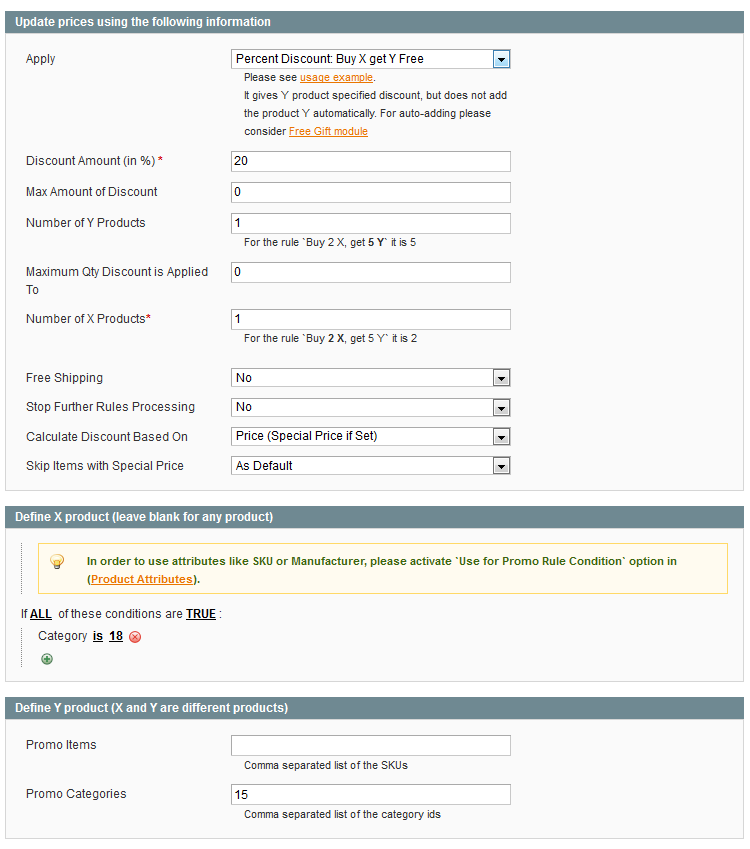
And here's the result for the rule above
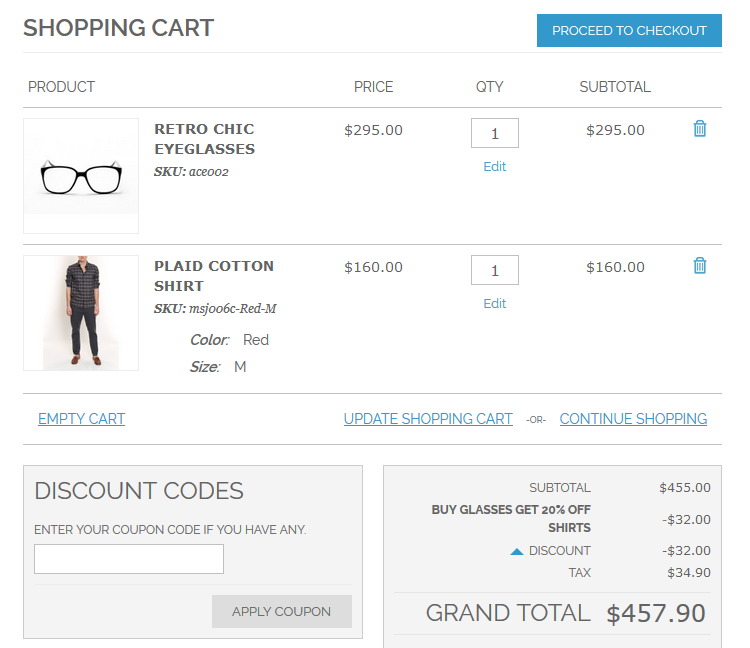
"Fixed Discount: Buy X get Y with $10 Off" action
This action will work the same as “Percent Discount: Buy X get Y Free” described above, except that it will apply a fixed amount discount when triggered.
"Fixed Price: Buy X get Y for $9.99" action
This action will work the same as “Percent Discount: Buy X get Y Free” described above, but instead of calculating a discount it will apply a custom price to the discounted product.
Each N-th
"Percent Discount: each 2-d, 4-th, 6-th with 15% Off" action
This action enables you to offer a percent discount in case a customer buys a specified number of items.
- Step 1. Choose the ‘Percent Discount: each 2-d, 4-th, 6-th with 15% off’ field.
- Step 2. Use ‘Each N-th’ to specify the number of items a customer should buy to get a discount.
The rule below will take 50% off each 5-th item in the cart
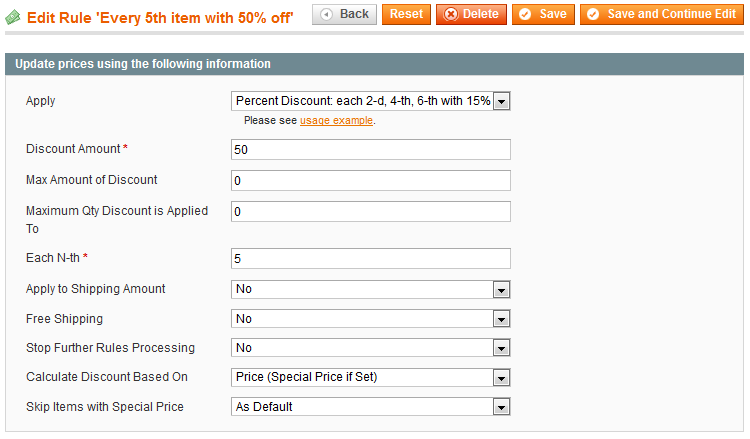 And here's the result for the rule above
And here's the result for the rule above
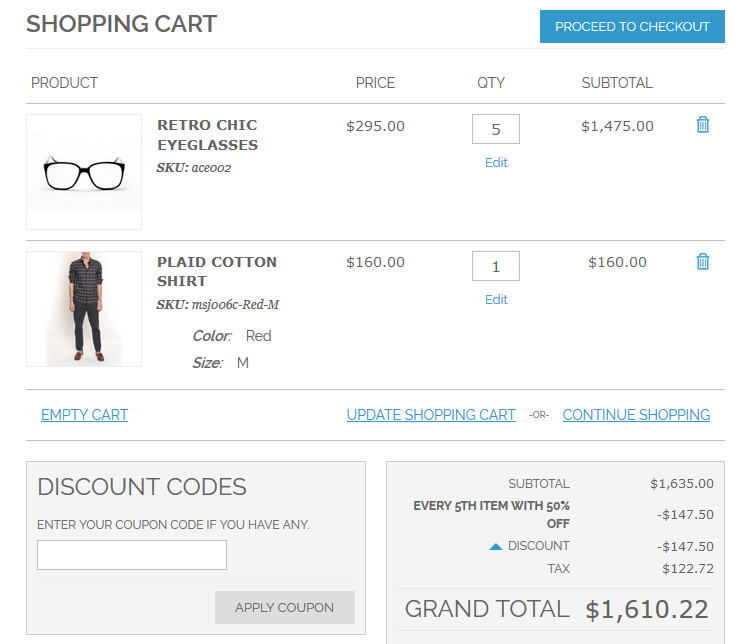
"Fixed Discount: each 3-d, 6-th, 9-th with $15 Off" action
This action will work the same as “Percent Discount: each 2-d, 4-th, 6-th with 15% Off” described above, except that it will apply a fixed amount discount when triggered.
"Fixed Price: each 5th, 10th, 15th for $49" action
This action will work the same as “Percent Discount: each 2-d, 4-th, 6-th with 15% Off” described above, but instead of calculating a discount it will apply a custom price to the discounted product.
Each Product After N
"Percent Discount: each 1st, 3rd, 5th with 15% 0ff after 5 items are added to the cart" action
This action lets you create promotions like ‘Buy 3 books for the full price and get each second one with a 15% discount’.
- Step 1. Choose the ‘Percent Discount: each 1st, 3rd, 5th with 15% 0ff after 5 items are added to the cart’ field.
- Step 2. Use the ‘Each Product (step)’ field to indicate a discount step. If you indicate ‘2’ like it's shown below, it means that each second item, that meets the rule conditions, will go with a 20% discount.
- Step 3. Use the ‘After N’ setting to indicate the number of ‘N’ items. If you specify 3 like here, it means that a customer will have to buy 3 ‘N’ items to get a 20% discount for each second item, in this case for the 5th, 7th, 9th item and so on.
And here's the rule which will give each second item after the purchase of 3 products for free
 Here's the diagram for this rule
Here's the diagram for this rule
 This is how the result will look like in the cart
This is how the result will look like in the cart

"Fixed Discount: each 3d, 7th, 11th with $15 0ff after 5 items added to the cart" action
This action will work the same as “Percent Discount: each 1st, 3rd, 5th with 15% 0ff after 5 items added to the cart” described above, except that it will apply a fixed amount discount when triggered.
"Fixed Price: each 5th, 7th, 9th for $89.99 after 5 items added to the cart" action
This action will work the same as “Percent Discount: each 1st, 3rd, 5th with 15% 0ff after 5 items added to the cart” described above, but instead of calculating a discount it will apply a custom price to discounted product.
Each Group of N
"Fixed Price: Each 5 items for $50" action
Using this action you can set up promotions like ‘Buy any four skirts for $500’.
- Step 1. Choose the ‘Fixed Price: Each 5 items for $50’ field.
- Step 2. Set the ‘Final Price For Group’.
- Step 3. Use ‘Each Group of N’ field to indicate a discount step. If you indicate ‘4’ like it's shown below, it will mean that every group of four items will trigger the discount.
- Step 4. Also, you can specify SKUs or categories of the individual products to which the discount should be applied.
The rule below will apply aforementioned ‘Buy any four skirts for $500’ discount
 And this is how the result might look like
And this is how the result might look like
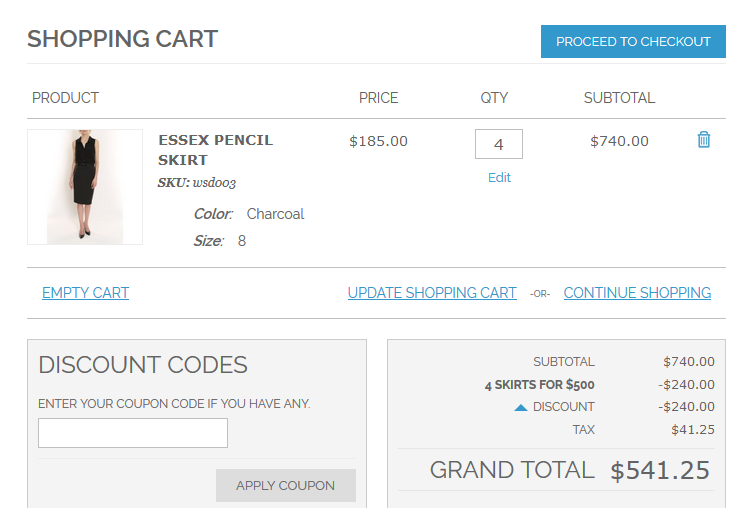
"Percent Discount: Each 5 items with 10% off" action
This action will work the same as “Fixed Price: Each 5 items for $50” described above, except that it will apply percent discount for a group of products when triggered.
Product Set
"Percent discount for product set" action
With this action you will be able to set ‘Buy sunglasses with a shirt and get a 20% discount’ promotion and many similar promotions.
- Step 1. Choose the ‘Percent discount for product set’ field.
- Step 2. Specify SKUs or category IDs in the ‘Product Set’ fields. Here you define a set of products that will trigger the discount.
The rule below will apply ‘Buy sunglasses with a shirt and get 20% discount’ promotion

And this is how the result may look like for a setup above

"Fixed price for product set" action
This action will work the same as the “Percent discount for product set” described above, except that it will apply custom fixed price for a product set when triggered.
Rules based on purchases history
"Total Sales Qty" condition
With the “Total Sales Qty” condition, you can create promotions for items that were bought previously. For example, “If you purchased iPhone 6, you could get any accessory for it with a 50% discount”.
1 Step. The condition you can find in the 'Items Subselection' tab.
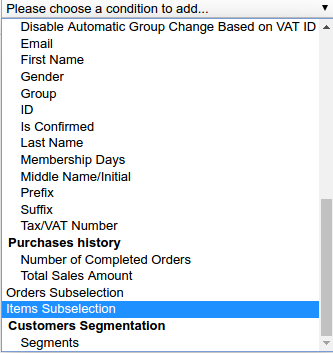
2 Step. If your promotion is dedicated to the specific item or items that were bought previously, you need to select SKU and then specify it (them).
Select Attribute Set if your promotion is dedicated to a wide range of purchased products (for example, 'Apple products' or 'Smartphones').

General settings
Extension settings are located in: System > Configuration > Amasty Extensions > Special Promotions
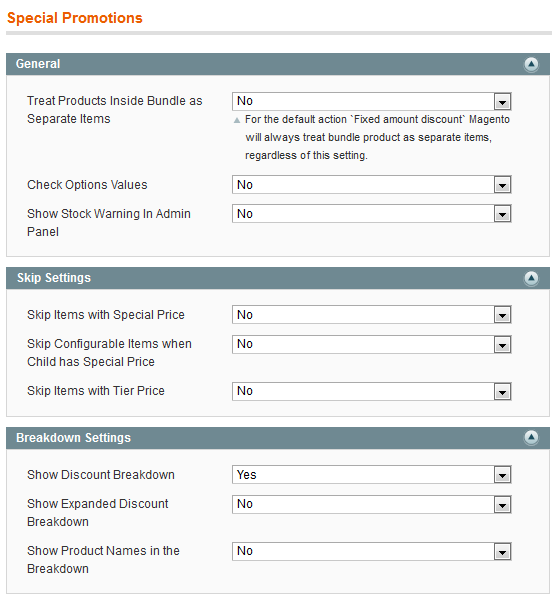
- ‘Treat Products Inside Bundle as Separate Items’ - as the name suggests, will treat bundle as a collection of Simple products.
- ‘Check Options Values’ - will allow you to use the ‘Custom option SKU’ condition to, for example, trigger a discount rule only when a particular Special Option was selected for a product.
- ‘Show Stock Warning In Admin Panel’ - while enabled, it will display a warning message when the SKU defined in the rule is 'Out of Stock' or has a negative Qty.
- ‘Skip Items with Special Price’ - with this setting enabled, products with Special Price applied won't receive discounts. The setting can be enabled or disabled for each rule individually.
- ‘Skip Configurable Items when Child has Special Price’ - same as in the setting above, but for cases when a Special Price is applied only for some options of a Configurable product.
- ‘Skip Items with Tier Price’ - same as for the products with Special Price, will not apply a discount on products with active Tier Price when enabled.
- ‘Show Discount Breakdown’ - will display the breakdown with names of the applied promotion rules on a cart page when enabled.
- ‘Show Expanded Discount Breakdown’ - controls whether the discount breakdown will be collapsed or expanded on the cart page load.
- ‘Show Product Names in the Breakdown’ - when enabled, it will display the actual product on which the discount was applied in a discount breakdown.
Time and day conditions
Special Promotions extension expands Magento promotion rules functionality allowing you to set up rules so that they will be activated on particular days of the week or at a particular time of the day.
You can find these settings in the Rule Information tab in every promotion rule.
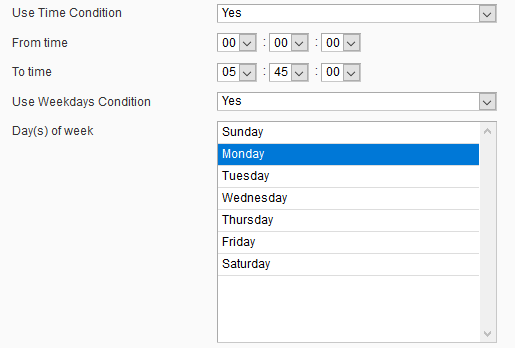
- ‘Use Time Condition’ - enables From time and To time conditions, which control the time of the day when the rule can be activated.
- ‘Use Weekdays Condition’ - enables Day(s) of week condition, which sets the day of the week when the promo rule can be activated.
Banners
Please see Promo Banners Lite guide.
Special Promotions Pro specific features
Special Promotions Pro expands Special Promotions capabilities by introducing a set of conditions which check customers' purchase history and account details.
- Subtotal Without Special Price - this condition will check Subtotal value without any discounts applied to it.
- Customer Attributes condition group will check the values of attributes saved in a customer account.
- Number of Completed Orders will check the orders placed on the store and select customers who completed defined number of products
- Total Sales Amount will sum up totals of completed orders placed by the same customer and compare the results with the value defined in condition.
- Orders subselection is very similar to Number of Completed Orders and Total Sales Amount but allows you to define orders statuses and order dates which will be checked, instead of checking all orders with Complete status only as for the conditions above.
- Item subselection works similarly to Orders subselection but instead of dealing with order statuses and dates it will check products' SKUs and Attribute Set.
Loyalty Program specific features
Loyalty Program extension has all the features from both Special Promotions and Special Promotions Pro modules but also adds a page to a customer account where you can display information about the loyalty program you run on your store with goals, levels, and discounts for each level along with the purchase history overview.
Loyalty Program settings
Extensions settings are located here: System - Configuration - Amasty Extensions - Loyalty Program.
By enabling the Progress Bar feature you can display a progress bar with discounts and levels on the Loyalty Program page in a customer account.
Enabling the Customer Account feature will allow you to add a description of your loyalty program. You can use simple HTML tags to style the text in the Description field.
This is how the result of settings above may look like on the Loyalty Program page:
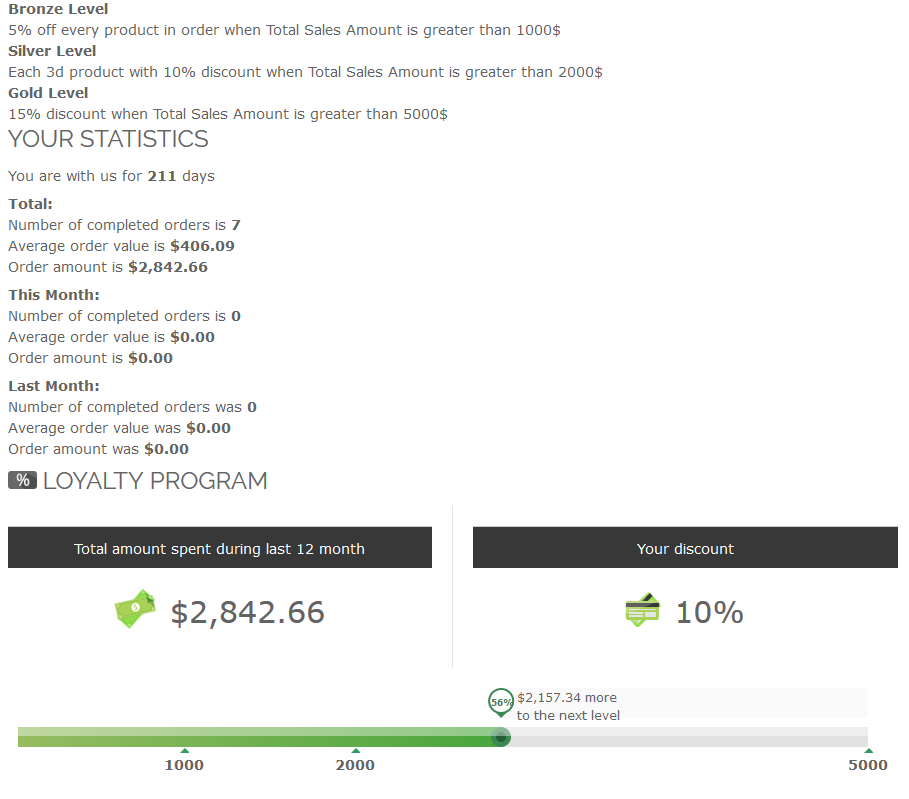
 With Labels enabled the text indicating the current loyalty program level will be added at the top of the Loyalty Program page.
With Labels enabled the text indicating the current loyalty program level will be added at the top of the Loyalty Program page.
Please note that these settings won't apply any discounts for customers. For this, you have to set up promotion rules using customer purchase history conditions.
magento_1/special-promotions.txt · Last modified: 2019/11/14 14:36 by arhipenko

